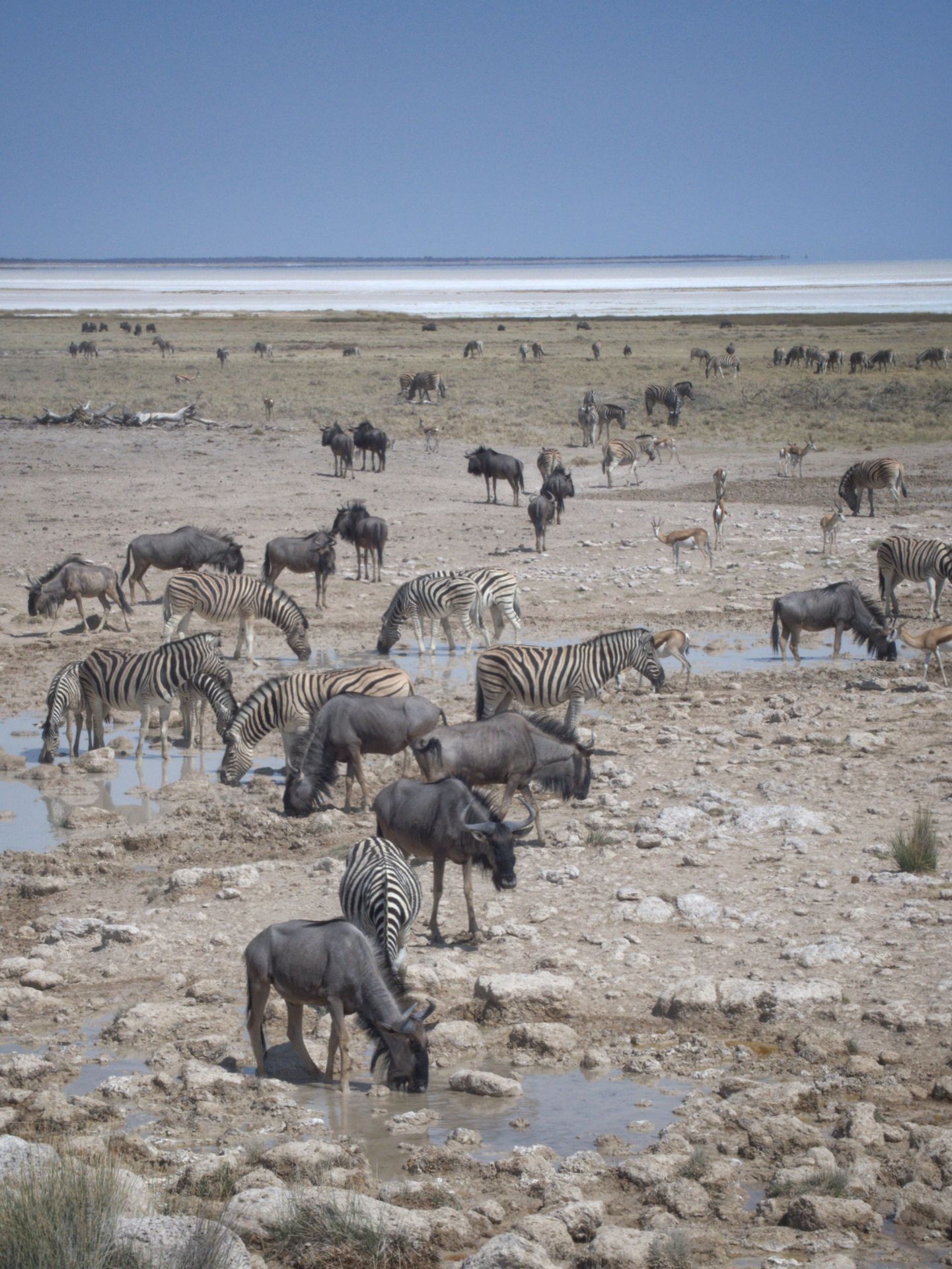Etosha is the largest and most popular National Park for game watching in Namibia. It was one of the highlights of our trip, and we built the whole itinerary around the availability of accommodation there. It is therefore with extremely high excitement and expectations that we entered the park on September 7th for 7 nights. We had managed to secure campsites in Namutoni and Halali meaning that we would focus on the eastern section of the park.
Discovery of Namutoni
We entered early afternoon through the east gate and drove straight to Namutoni to check in. The camp is built in a former German fort. The setting with white walls is nice, but the campsite area is not overly exciting. With charmless and rather small campsites, we were a far cry from the wilderness of Botswana… We picked up the site we liked the most, had a coffee at the restaurant and left again for a quick safari. But overall, this first impression of the facilities was a disappointment.
Luckily the first impression of the park itself was the opposite: beautiful scenery with large plains and numerous waterholes to observe wildlife, very unique atmosphere and colours, it was love at first sight. The impalas there are also an interesting find as it is the only place where they are black faced. Having said that, there are so many of them in the park that the interest does not last long. The drive was not eventful wildlife-wise, but our hopes were intact. We had dinner at the restaurant and went to the camp’s waterhole. This is a specificity of Etosha: all camps inside the park have their own waterhole with a 24 hours access. Even once back inside the fenced facility, the wildlife frenzy can continue. It was quiet when we went, and we were tired from our long day, so patience reached out its limit very quickly. Instead, we went for a well-deserved sleep to be ready for the next morning.
We decided to explore the surroundings of Namutoni, starting by the northern circuits. Zebras, wildebeests, springboks, impalas and southern yellow-billed hornbills greeted us along the way to Tsumcor waterhole. Once there, couple of cars stationed on the side were evidence of a sighting. And indeed, a male lion was sleeping in the bushes. We could not see him very clearly, but it was super exciting to have one in our first few hours in the park! We waited a bit, but he showed absolutely no sign of movement, so we headed further north.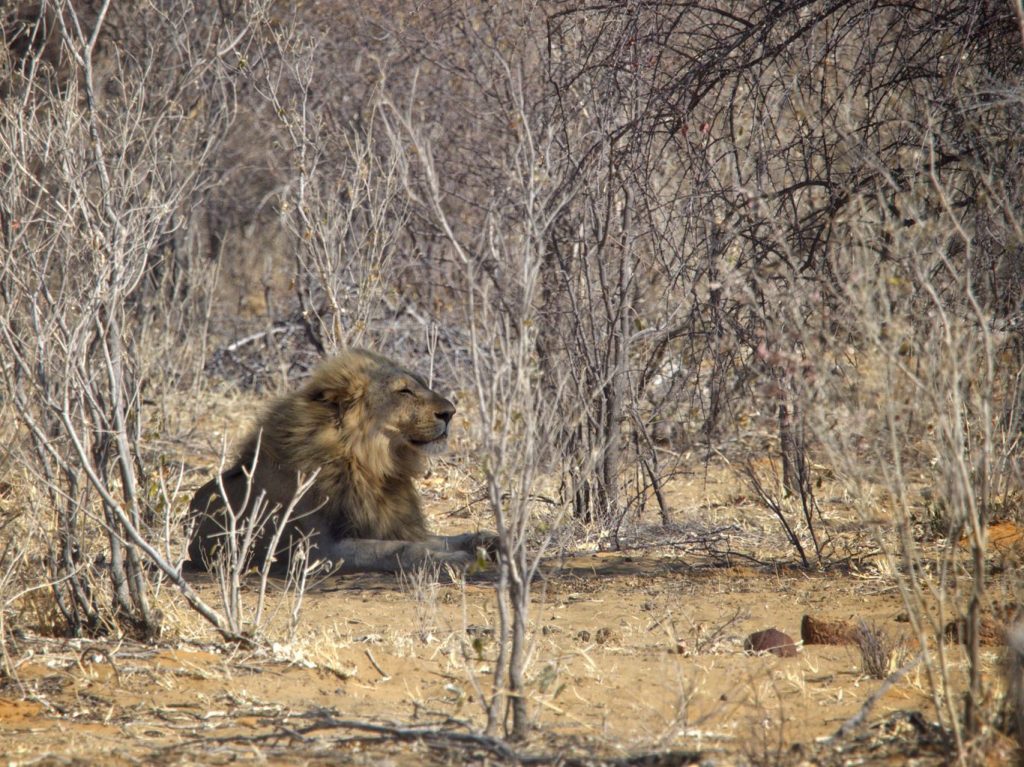 The scenery was incredible: flat plains, white unsealed roads, deep blue sky. But what struck us the most was the size of the herds. We had never seen such large groups of zebras, wildebeests, impalas and springboks, even in Kruger. They were all either queueing at the waterholes or grazing in the plains waiting for their turn to drink. There were hundreds of them around Stinkwater waterhole. It was really impressive. We drove back to the camp for lunch, stopping again at the lion on the way, but he had moved further into the bushes, making him even more difficult to see.
The scenery was incredible: flat plains, white unsealed roads, deep blue sky. But what struck us the most was the size of the herds. We had never seen such large groups of zebras, wildebeests, impalas and springboks, even in Kruger. They were all either queueing at the waterholes or grazing in the plains waiting for their turn to drink. There were hundreds of them around Stinkwater waterhole. It was really impressive. We drove back to the camp for lunch, stopping again at the lion on the way, but he had moved further into the bushes, making him even more difficult to see.
The afternoon did not disappoint, especially around the Klein Namutoni waterhole. First, we saw the biggest meeting of giraffes we had ever seen. More than twenty of them gathered at the same time. All sizes and shades of brown were in display, and we stayed a long time to observe the slow and graceful walking movements of these giants, smiling at their yet ungracious drinking style. We also saw several dik-dik, the tiniest antelope of all. The only place where we spotted them was on the “dik-dik drive”. The encounter seemed pretty much obvious with this name, but we had been fooled so many times before with “Cheetah plains” having no cheetahs or other “Elands roads” without elands – just to name a few – than we were initially sceptical. They are cute from afar with their tiny horns, but their snort gives them a weird look when you get closer. But it was our first encounter with these small mammals, so we were quite excited.
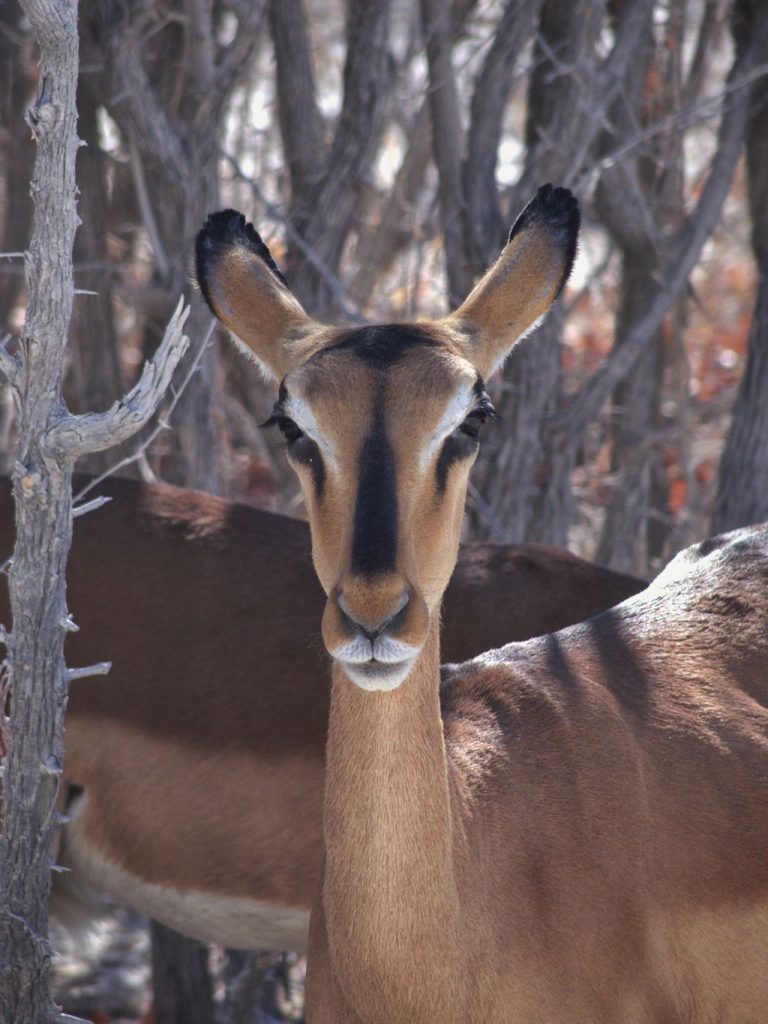
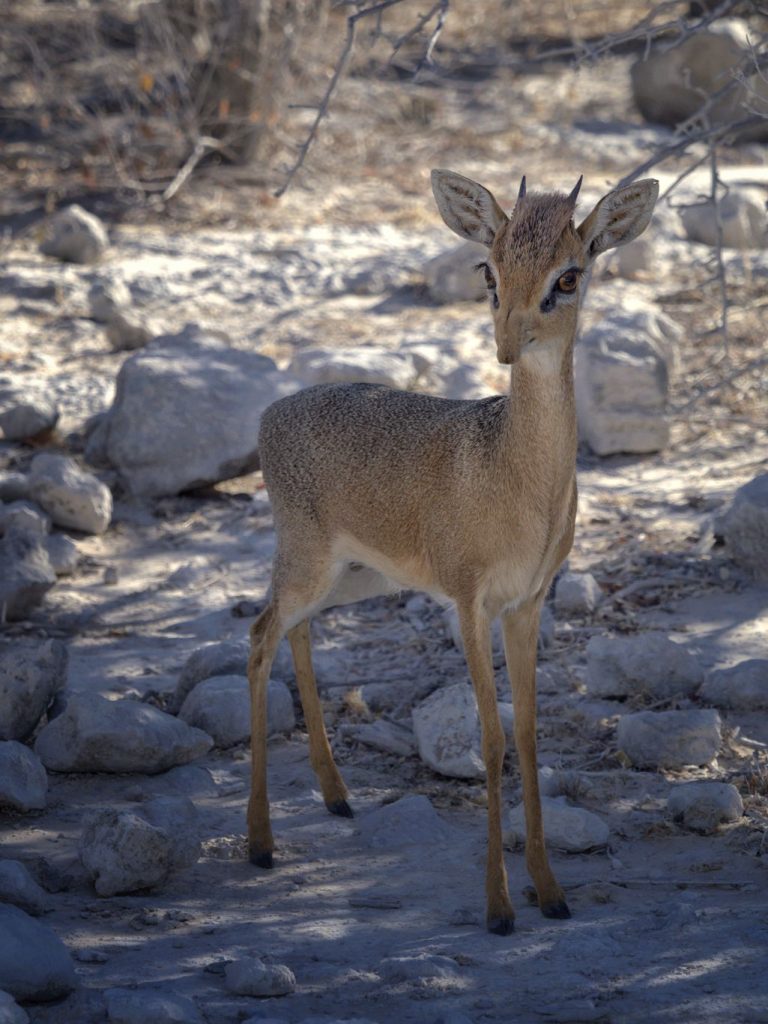 We were on our way back to the camp when we saw few cars stopped along the road. We asked and they told us that rhinos were wandering around. We waited as well and finally spotted them. A mum and a baby black rhinos! They came really close to the car. Both still had their horn and were very cute, especially the little one with his ears too big for his head. It was an amazing sighting concluding an amazing first day.
We were on our way back to the camp when we saw few cars stopped along the road. We asked and they told us that rhinos were wandering around. We waited as well and finally spotted them. A mum and a baby black rhinos! They came really close to the car. Both still had their horn and were very cute, especially the little one with his ears too big for his head. It was an amazing sighting concluding an amazing first day.
Note: Cutting rhino horns is a practice being deployed in the park to prevent poaching. Horns are properly cut few centimetres above the base to keep the animals alive. Unfortunately, it is sometimes not enough as poachers still try to scrap the remainder of the horn. Poachers also kill just to have less leads to hunt. What an insane world we live in…
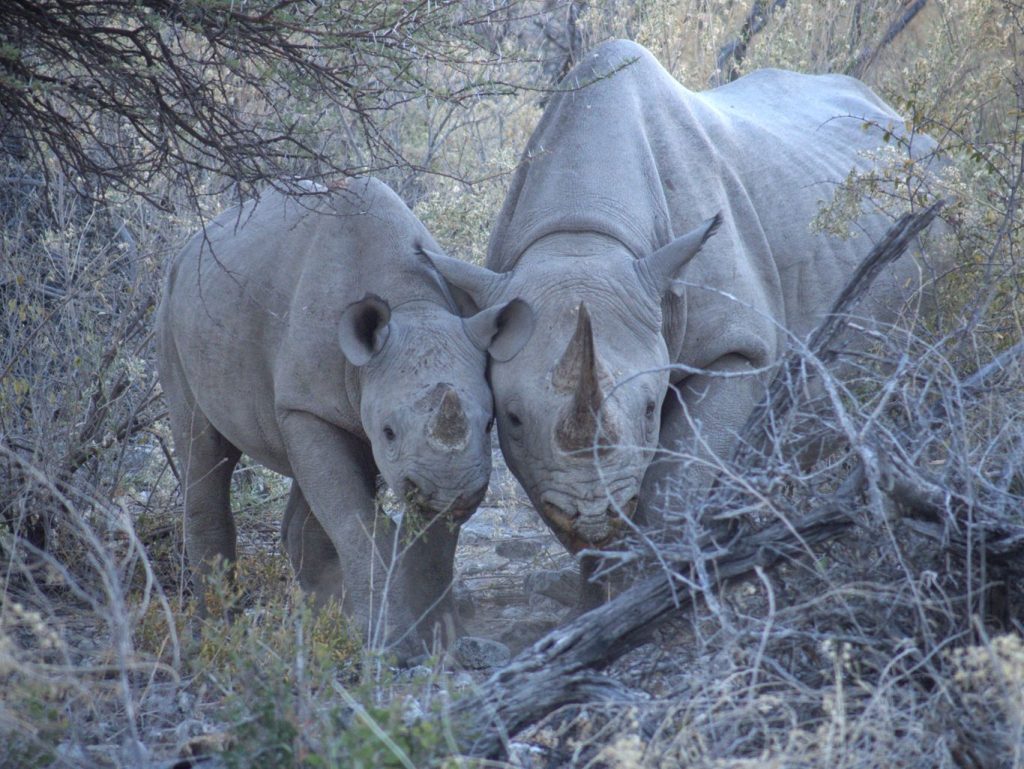 Unfortunately, the evening at the camp was not so great. There was no charm nor coziness whatsoever, and the waterhole remained quiet and uninviting.
Unfortunately, the evening at the camp was not so great. There was no charm nor coziness whatsoever, and the waterhole remained quiet and uninviting.
Big 4 on the way to Halali
Our third night was in Halali 75 km away from Namutoni. We got up early, explored the waterholes around Namutoni and headed to Halali. If the first day had been amazing, the second was even more fantastic. We saw 4 or the Big 4 of the park: rhinos, elephants, lions and leopards.
Note: There is no buffalos in Etosha. It is too dry for them. But Etosha has both white and black rhinos, which can count for a Big 4+.
First one was only few metres away from the gate. A white rhino was roaming just at the exit of the camp in a distance. We observed him for a short while, but he went the opposite direction to hide in the bushes. The drive was fun spotting giraffes, ostriches, oryx, springboks and black-faced impalas. There was also another massive herds of zebras with some of them fighting. Apparently, it was matting season and males can become extremely aggressive during this time. They were really at it, biting each other and kicking hard. We understood where massive scars we saw on some of them the day before came from. We thought one very much injured and unwell had been attacked by a lion, but we realized he had been fighting with one of his peers instead. They look so peaceful and harmless usually. It was quite interesting to witness the other side of their temper.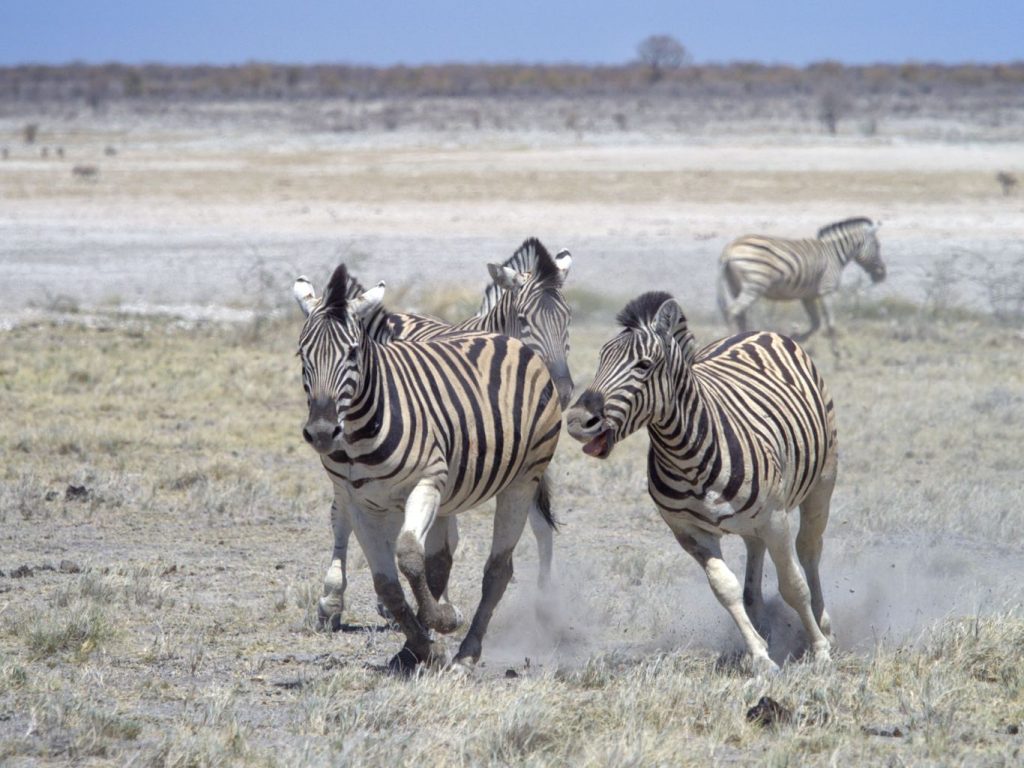 Later, we finally crossed path with our first elephant since our arrival. What a massive bull he was! Light-grey in colour, with rather small tusks, which we learnt later is common for Etosha’s elephants.
Later, we finally crossed path with our first elephant since our arrival. What a massive bull he was! Light-grey in colour, with rather small tusks, which we learnt later is common for Etosha’s elephants.
Note: Etosha’s elephants have several characteristics:
- They are the largest in Africa, the tallest reaching up to four metres at the shoulder.
- They are lighter in colour, sometimes even white, because they cover themselves with the white mud of the pan – Etosha means “Great white place”.
- They have small and easily breakable tusks due to deficiencies in their diet. This is a distinct advantage as they are less likely to be targeted by ivory poachers.
A bit later, an even bigger and whiter one was quietly grazing the bushes along the road. He was so close and so big that I got a bit nervous again. It seemed that my phobia started in Botswana had crossed the border with me. Damn it…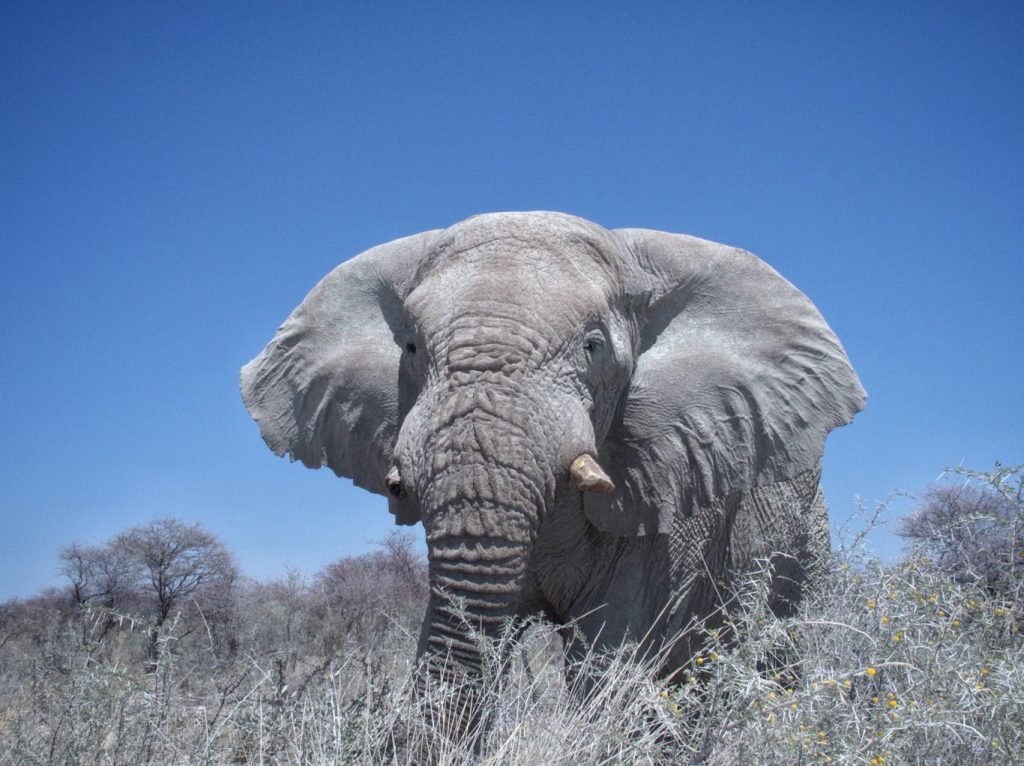 We drove past him, and it was not long before we had to stop again. This time there were several vehicles stationed along the track, near thick bushes. A leopard had been spotted and was sleeping under the trees. We waited a while, but only managed to have a glimpse of him, as he was moving around. Probably it was a bit too crowded for him, so he stayed mostly hidden. We left without a good shot, but with big smiles. Three out of four of the big 4 in less than three hours, it was our lucky day! And we won the jackpot when we arrived at Okerfontein waterhole. Two lionesses were lying down near the waterhole, one of them almost invisible in the grass. We could only spot her when she was rising slightly to check on suspicious noises and movements. It was funny to observe the wildlife around, still queuing to get to the waterhole, but staying cautiously far enough from the predators in case they decide to go for a snack.
We drove past him, and it was not long before we had to stop again. This time there were several vehicles stationed along the track, near thick bushes. A leopard had been spotted and was sleeping under the trees. We waited a while, but only managed to have a glimpse of him, as he was moving around. Probably it was a bit too crowded for him, so he stayed mostly hidden. We left without a good shot, but with big smiles. Three out of four of the big 4 in less than three hours, it was our lucky day! And we won the jackpot when we arrived at Okerfontein waterhole. Two lionesses were lying down near the waterhole, one of them almost invisible in the grass. We could only spot her when she was rising slightly to check on suspicious noises and movements. It was funny to observe the wildlife around, still queuing to get to the waterhole, but staying cautiously far enough from the predators in case they decide to go for a snack.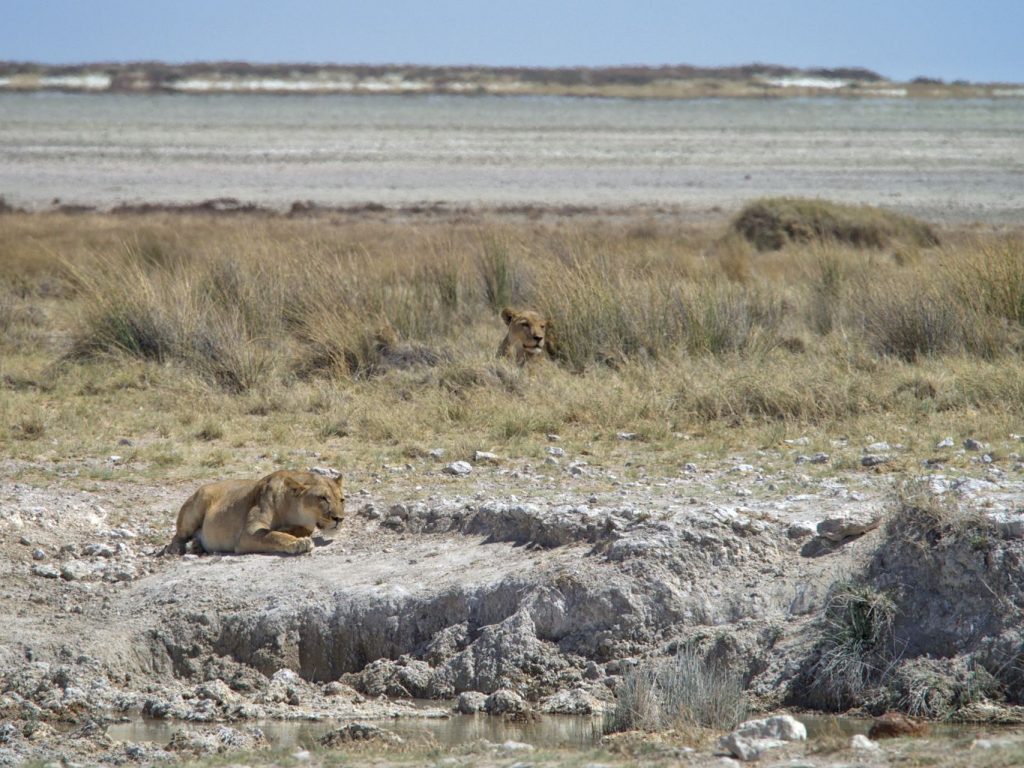 Speaking of snack, we were quite hungry and decided to go and check in in Halali camp to have lunch there. If Namutoni’s facilities disappointed us, Halali’s were even worse. The communal area near the reception is ok, but the restaurant was bare, uninviting, people at the reception were quite unfriendly, and the camping area was simply awful. Small campsites were disseminated on a large dusty and sandy area where there was absolutely no shade. It was like being back to a European campground, crowded and where intimacy was prohibited. It would not be a cosy place to have dinner and drinks… We were a bit depressed by the atmosphere when we left for our afternoon drive.
Speaking of snack, we were quite hungry and decided to go and check in in Halali camp to have lunch there. If Namutoni’s facilities disappointed us, Halali’s were even worse. The communal area near the reception is ok, but the restaurant was bare, uninviting, people at the reception were quite unfriendly, and the camping area was simply awful. Small campsites were disseminated on a large dusty and sandy area where there was absolutely no shade. It was like being back to a European campground, crowded and where intimacy was prohibited. It would not be a cosy place to have dinner and drinks… We were a bit depressed by the atmosphere when we left for our afternoon drive.
We drove straight to Goas waterhole, as lions had been spotted there. There were none when we arrived, but people stationed there told us a leopard was sleeping in a tree. And indeed, a long spotted tail swaying between branches was a hint of his presence. That would be our mission of the day: no more drive, we would wait for some action, hoping for the cat to come down and drink. We could see the cat moving from one branch to another. He was clearly on a hunting mode as soon as a prey was approaching. He swiftly moved his position, starting to climb down when couple of impalas went his way. But they changed their direction, and the leopard was then too far to be able to jump and be successful on his hunt. So, he went back up for another nap. Disappointment followed utter excitement for us and the other people around. We had another peak of adrenaline when a family of giraffes came close. The leopard looked like he was about to jump on the baby, but finally did not. It was a bit out of his league and dangerous for him. We would have stayed longer but it was time to go back to the camp before the gates close. Eff drove as fast as he could (almost within the speed limits), and we managed to get through right on time. Our hopes had not been fulfilled, but it had been a very suspenseful afternoon.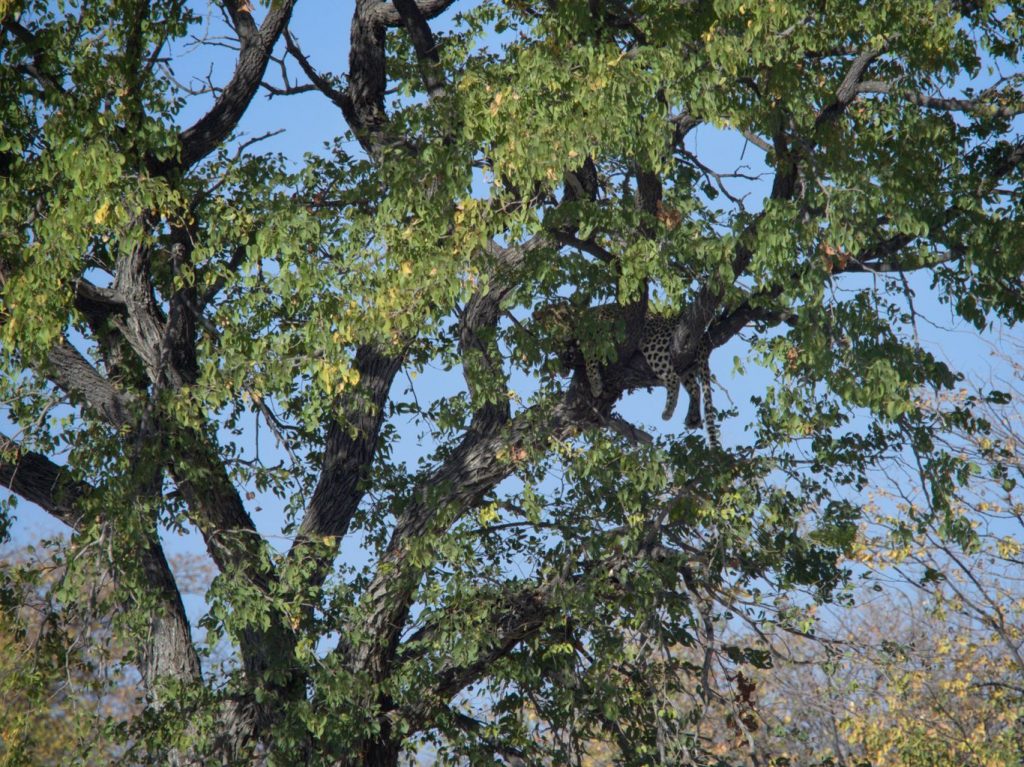 We had a quick dinner at our campsite – which was even less cosy at night than during the day – and went straight to the waterhole. Just like Namutoni, Halali has one that you can access from within the camp twenty-four hours a day. How fabulous that one is! Nested is a serene and beautifully man-made setting, it is a relaxed place to spend the evening. There were many people, but it was not a problem as everyone was quiet and focused on any activity around the waterhole. We did not wait long before a hyena came around. She drank a bit and continued her route inside the bushes. We were about to leave when a black rhino came too. We were ecstatic! It was the missing specie to tick the Etosha Big 5 in one day. He walked around the waterhole and eventually made his way to a short path going inside the waterhole. The light created a magnificent reflection of the rhino into the black water. He stayed there for a while posing like a model. Tired by our long day, we decided this sighting to be the cherry on the cake and went to rest. We had only one night in Halali and the day after was another day of driving back to Namutoni.
We had a quick dinner at our campsite – which was even less cosy at night than during the day – and went straight to the waterhole. Just like Namutoni, Halali has one that you can access from within the camp twenty-four hours a day. How fabulous that one is! Nested is a serene and beautifully man-made setting, it is a relaxed place to spend the evening. There were many people, but it was not a problem as everyone was quiet and focused on any activity around the waterhole. We did not wait long before a hyena came around. She drank a bit and continued her route inside the bushes. We were about to leave when a black rhino came too. We were ecstatic! It was the missing specie to tick the Etosha Big 5 in one day. He walked around the waterhole and eventually made his way to a short path going inside the waterhole. The light created a magnificent reflection of the rhino into the black water. He stayed there for a while posing like a model. Tired by our long day, we decided this sighting to be the cherry on the cake and went to rest. We had only one night in Halali and the day after was another day of driving back to Namutoni.
Back to Namutoni
As we would come back to Halali for another 3 nights, we decided to explore its surroundings later. Instead, we headed East towards Namutoni, taking the tracks along the pan instead. The scenery there is incredible: desertic moon-like atmosphere with endless white pans under a crisp blue sky. We were alone in the middle of nowhere, floating in this surreal landscape. At some point, we were so mesmerized by a massive elephant walking in a distance that we missed a lion that was sleeping on the edges of the pan. Luckily, a friendly couple stopped us to give us the tip, so we turned around. The lion was there, relaxed and enjoying the morning breeze. He was a bit far, so we headed back towards our elephant.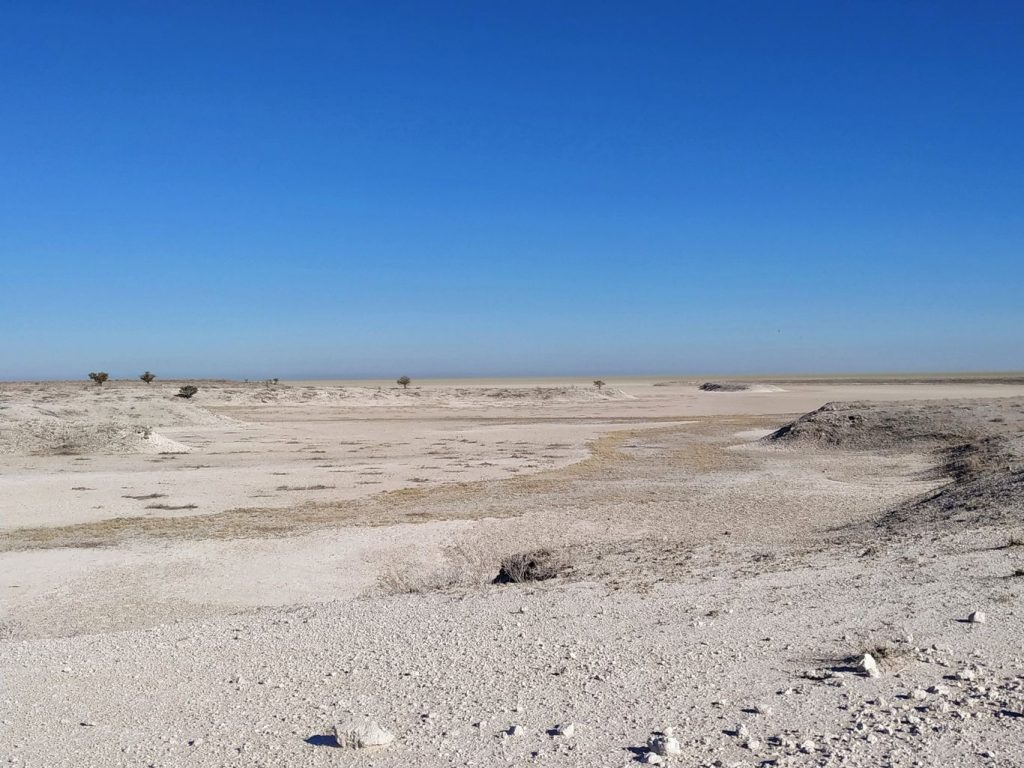 We saw another big mass from afar, thinking it was another elephant but instead there was a big white rhino roaming around. At least they are quite easy to spot! Big and grey on flat white plains, it could not be easier.
We saw another big mass from afar, thinking it was another elephant but instead there was a big white rhino roaming around. At least they are quite easy to spot! Big and grey on flat white plains, it could not be easier.
Note: Do you know how to make the difference between white and black rhinos? Not the colour, they have the same!
- Black rhinos have rounded jaws and are browsers. You find them in bushy areas. They are shier and more aggressive. Watch out as they are not afraid to chase your car.
- White rhinos have squared jaws and are grazers. You can find them in grassy open areas.
We stopped again at Okerfontein to check on the lionesses, but they were gone. Instead there were elephants bathing. It was around midday and likely to be bath time for them, because at least ten of them came and went while we stayed at the waterhole. We could see them coming from behind, massive whitish beasts making their way through a handful of cars to get to the water. They were very impressive once again. Having them merely metres away from us made me nervous, but the show was yet so great that it offset the fear. The ritual was the same: drink, enter the water, splash themselves, go out and cover themselves in white dust. Many impalas and springboks were around, watching the pachyderms and waiting for them to leave.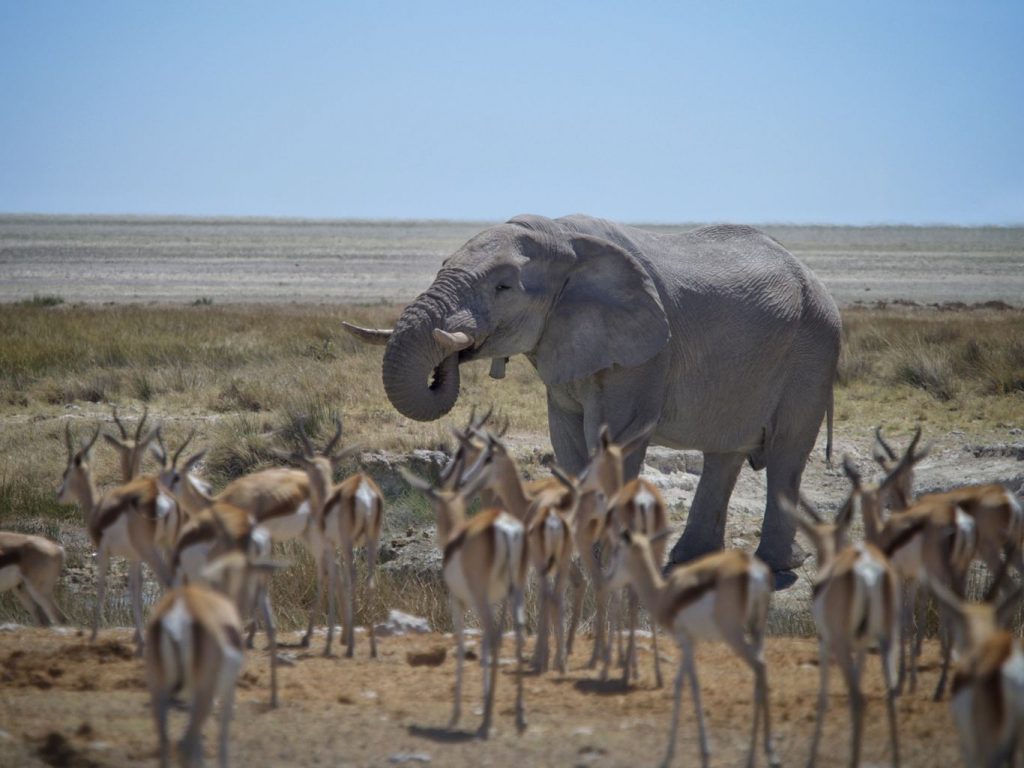 We left after a while to have lunch. There was a fenced area nearby with bathroom and picnic facilities. What a let-down they were! Awful place, with no shade, and the most disgusting toilets we had since the beginning of this entire trip. Etosha is pricey so you would expect much better facilities, at least clean ones. The basic facilities in the remote camps in Botswana were luxurious in comparison. Needless to say, the lunch break was quick.
We left after a while to have lunch. There was a fenced area nearby with bathroom and picnic facilities. What a let-down they were! Awful place, with no shade, and the most disgusting toilets we had since the beginning of this entire trip. Etosha is pricey so you would expect much better facilities, at least clean ones. The basic facilities in the remote camps in Botswana were luxurious in comparison. Needless to say, the lunch break was quick.
The rest of the day was quieter. We stopped at Namutoni for check in and choose a campsite, had a coffee, and went for the last drive of the day. At a waterhole, a massive herd of elephants came to bath. The parade was counting at least twenty members including massive mums, young and babies of various ages. They slowly walked to the waterhole and followed their ritual. Some were happily rolling themselves in the muddy waters, clearly enjoying themselves a lot. The small ones were as clumsy as usual, trying mostly unsuccessfully to mimic their mums, and rolling themselves in the dust to cover up instead of using their trunks. The show lasted a long time, until it was time for us to drive back to the camp.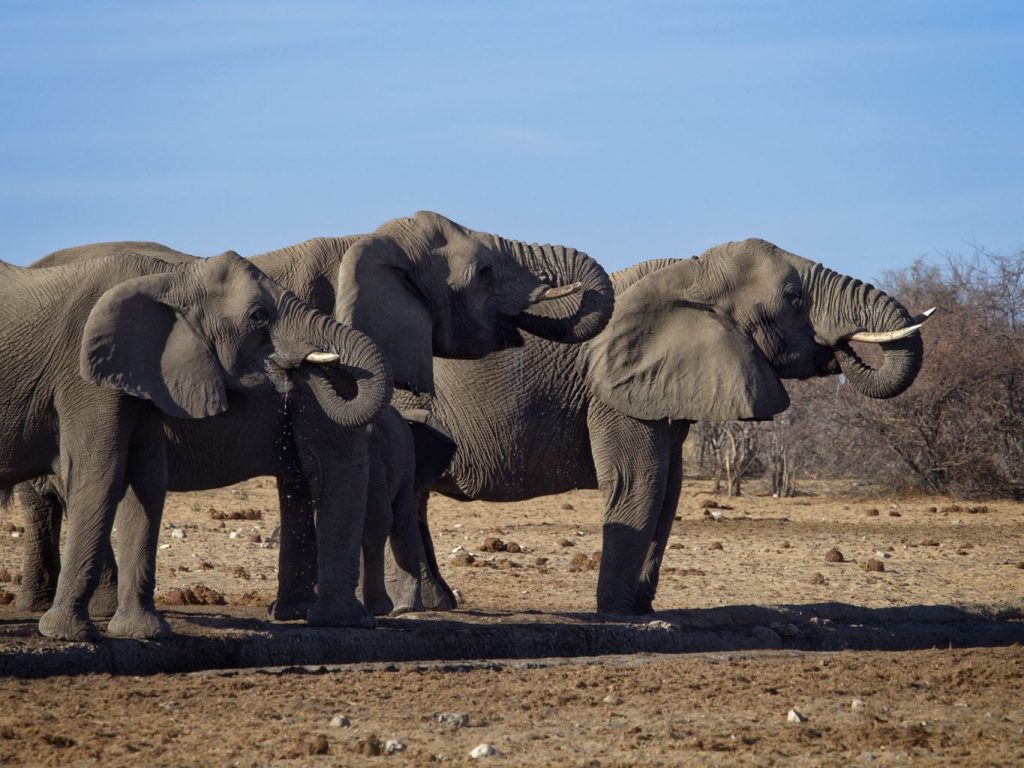 We had dinner at the restaurant which is much nicer than Halali’s. Enjoying a glass of wine, we were happy. We had had another full day of surprises and were completely in love with the place. And the best was that there were another four days to go.
We had dinner at the restaurant which is much nicer than Halali’s. Enjoying a glass of wine, we were happy. We had had another full day of surprises and were completely in love with the place. And the best was that there were another four days to go.
Photo gallery






































